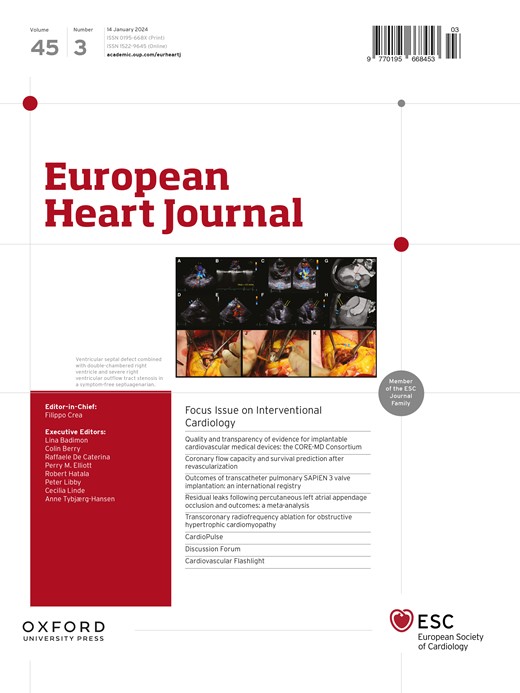Impella治疗急性心肌梗死相关性心源性休克的危险休克标准和结果:J-PVAD登记
IF 35.6
1区 医学
Q1 CARDIAC & CARDIOVASCULAR SYSTEMS
引用次数: 0
摘要
背景和目的:危险休克试验显示,在经过高度筛选的st段抬高心肌梗死相关心源性休克(STEMI-CS)患者中,Impella可提高生存期。然而,在现实环境中,Impella通常用于不符合试验标准的更广泛人群。本研究旨在评估日本全国范围内急性心肌梗死相关性心源性休克(AMI-CS)患者的分布和结局。方法从J-PVAD注册表中确定了2020年至2023年间接受Impella治疗的3975例AMI-CS患者。患者被分为五组:符合条件的STEMI-CS、不符合条件的STEMI-CS、院外心脏骤停(OHCA)、机械性并发症(MCs)和非STEMI-CS (NSTEMI-CS)。符合STEMI-CS的定义是STEMI-CS满足以下所有条件:乳酸≥2.5 mmol/L,收缩压<100 mmHg或使用儿茶酚胺,左心室射血分数<45%,休克发作至首次Impella支持≤24 h。对五组患者的30天死亡率、相关危险因素和并发症进行检查。结果符合条件的STEMI-CS占所有AMI-CS病例的35.6%,30天死亡率为37.6%。不符合条件的STEMI-CS患者死亡率较低(27.6%),但随着高龄、肾功能不全、静脉-动脉体外膜氧合使用、室性心律失常或败血症,死亡率显著增加。OHCA组30天死亡率为51.3%(无自然循环恢复为63.4%),MC组为39.8%,NSTEMI-CS组为33.3%。结论:在这个全国性的登记中,三分之一接受Impella治疗的AMI-CS患者符合危险休克标准。非合格亚组的结果是异质的,突出了个体化风险评估在指导Impella在现实世界中使用的重要性。本文章由计算机程序翻译,如有差异,请以英文原文为准。
DanGer shock criteria and outcomes in acute myocardial infarction-related cardiogenic shock treated with Impella: the J-PVAD registry.
BACKGROUND AND AIMS
The DanGer shock trial showed a survival benefit of Impella in highly selected patients with ST-elevation myocardial infarction-related cardiogenic shock (STEMI-CS). In real-world settings, however, Impella is often used in broader populations not meeting trial criteria. This study aimed to assess the distribution and outcomes of DanGer shock-eligible and -ineligible acute myocardial infarction-related cardiogenic shock (AMI-CS) patients in a nationwide Japanese registry.
METHODS
A total of 3975 AMI-CS patients treated with Impella between 2020 and 2023 were identified from the J-PVAD registry. Patients were stratified into five groups: eligible STEMI-CS, non-eligible STEMI-CS, out-of-hospital cardiac arrest (OHCA), mechanical complications (MCs), and non-STEMI-CS (NSTEMI-CS). Eligible STEMI-CS was defined as STEMI-CS fulfilling all of the following: lactate ≥ 2.5 mmol/L, systolic blood pressure <100 mmHg or catecholamine use, left ventricular ejection fraction <45%, and shock onset to first Impella support ≤24 h. Thirty-day mortality, associated risk factors, and complications were examined across the five groups.
RESULTS
Eligible STEMI-CS accounted for 35.6% of all AMI-CS cases, with a 30-day mortality of 37.6%. Non-eligible STEMI-CS patients had lower mortality (27.6%), but it increased significantly with advanced age, renal dysfunction, veno-arterial extracorporeal membrane oxygenation use, ventricular arrhythmia, or sepsis. Thirty-day mortality was 51.3% in OHCA (63.4% without return of spontaneous circulation), 39.8% in MC, and 33.3% in NSTEMI-CS groups.
CONCLUSIONS
In this nationwide registry, one-third of AMI-CS patients treated with Impella met DanGer shock criteria. Outcomes in non-eligible subgroups were heterogeneous, highlighting the importance of individualized risk assessment in guiding Impella use in real-world practice.
求助全文
通过发布文献求助,成功后即可免费获取论文全文。
去求助
来源期刊

European Heart Journal
医学-心血管系统
CiteScore
39.30
自引率
6.90%
发文量
3942
审稿时长
1 months
期刊介绍:
The European Heart Journal is a renowned international journal that focuses on cardiovascular medicine. It is published weekly and is the official journal of the European Society of Cardiology. This peer-reviewed journal is committed to publishing high-quality clinical and scientific material pertaining to all aspects of cardiovascular medicine. It covers a diverse range of topics including research findings, technical evaluations, and reviews. Moreover, the journal serves as a platform for the exchange of information and discussions on various aspects of cardiovascular medicine, including educational matters.
In addition to original papers on cardiovascular medicine and surgery, the European Heart Journal also presents reviews, clinical perspectives, ESC Guidelines, and editorial articles that highlight recent advancements in cardiology. Additionally, the journal actively encourages readers to share their thoughts and opinions through correspondence.
 求助内容:
求助内容: 应助结果提醒方式:
应助结果提醒方式:


